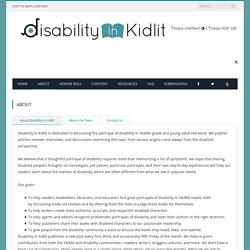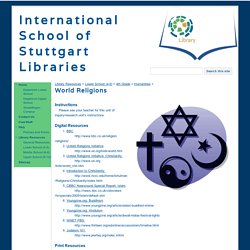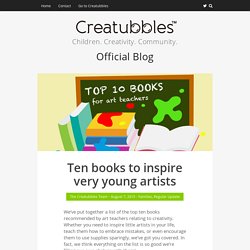PYP Libraries
> Betty_turpin
A video interview with Rudine Sims Bishop. Rudine Sims Bishop is Professor Emerita of Education at The Ohio State University, where she has taught courses on children’s literature. Her books include Shadow and Substance: Afro-American Experience in Contemporary Children’s Fiction (1982), Presenting Walter Dean Myers (1990), Kaleidoscope: A Multicultural Booklist for Grades K–8 (1994), Wonders: The Best Children’s Poems of Effie Lee Newsome (1999), and Free within Ourselves: The Development of African American Children's Literature (2007). In Free Within Ourselves, Dr. Bishop takes the reader on a historical journey, from the earliest works written about African American children (W.E.B. DuBois' The Brownies Book) to John Steptoe's Stevie to the contemporary award-winning writer Christopher Paul Curtis and his Bud, Not Buddy, winner of both the Newbery Medal and the Coretta Scott King Author Award.
About. Disability in Kidlit is dedicated to discussing the portrayal of disability in middle grade and young adult literature.

Kody Keplinger, co-founder and fairy godmotherDisability in Kidlit postsTwitterYouTube Kody is the New York Times and USA Today bestselling author of several books for kids and teens, including The DUFF, which was adapted into a major motion picture in 2015, and a companion novel, Lying Out Loud. Her most recent book, Run, was released in June 2016. Kody is also a writing teacher, a guide-dog user, and a body-positive fashion lover.She was born legally blind and, at age eight, diagnosed with a condition known as Leber’s Congenital Amaurosis, which leaves her with poor light perception and tunnel vision.
You can reach the editors at team@disabilityinkidlit.com. Before you do so, please read our FAQ.
Ten ways teacher librarians improve literacy in schools. Australian schools constantly strive to improve the literacy outcomes of their students. Supporting literacy achievement for struggling readers is particularly important because these readers have their disadvantage compounded: capable students develop “richer” skills through continued exposure to reading, and the gap between them and struggling readers widens.
The number of Australian students deemed “low performers” in reading literacy proficiency has been rising over time. Our percentage of high performers is shrinking – nearly one in five adolescents are in the low performer category. Read more: Six things you should do when reading with your kids With school about to start for the year, we should consider how we can optimise support for struggling readers.
Research suggests the presence of qualified library staff in school libraries is associated with better student performance in literacy. What do they do?
The Gift of Reading - The New York Times. World Religions - International School of Stuttgart Libraries. Instructions Please see your teacher for this unit of inquiry/research unit's instructions.

Digital Resources Print Resources 1. L200 DOR: What Do you Believe? 2. World Book Student Discovery Encyclopedia Oxford Children’s Encyclopedia World Book Encyclopedia 3. 222 and 296 Judaism 220 and 280 Christianity 294.3 Hinduism 294.5 Buddhism 297 Islam Extra Resources 2. Citation Tools Click here for tutorials on how to use resources. Libraries. 41eef9 9575d5178b864715b5f10ae04e586893. 50 Ways to Use Picture Books w ELA Students Final Handout. NESA: Shannon McClintock Miller. Ten books to inspire very young artists. We’ve put together a list of the top ten books recommended by art teachers relating to creativity.

Whether you need to inspire little artists in your life, teach them how to embrace mistakes, or even encourage them to use supplies sparingly, we’ve got you covered. In fact, we think everything on the list is so good we’re filling our own shelves with them! Is your favorite book missing? Please let us know in the comments below! 1. This is a story for anyone, of any age, who’s ever had an idea that seemed a little too big, too odd or too difficult. 2.
This New York Times bestseller teaches kids about mixing color – but without all the mess! 3. Funny, engaging and a bit goofy, this beautifully illustrated and colourful book is great to read to younger kids around K2 level. 4. Crayons have feelings too! 5. This one-of-a-kind interactive book that shows young readers how every mistake is an opportunity to make something beautiful.
The PYP Library.



